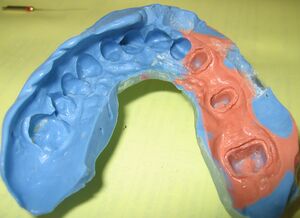Impression materials
Impressions are auxiliary prosthetic materials. It is used to transfer information about the state in the oral cavity to the laboratory. For a complete overview of this condition, it is necessary to provide situational, antagonal and occlusal imprints.
Properties[edit | edit source]
- Accuracy of reproduction
The accuracy of the reproduction of details of imprinted jaws is important for making a very good replacement. For the most successful reproduction of details, it is necessary to imprint both the working jaw and the opposite jaw. The accuracy of imprints depends on the choice of impression material, its viscosity, flowability, volume stability. Elastomers imprint details with an accuracy of 25 μm. Another factor influencing the accuracy of the imprint is the type of model mass.
- Elastic deformation
Elastic deformation (or shape memory) is important when taking imprints from undercut places where we have to deform the imprint material to remove it without damage. The impression material must then be able to return to the state in which it faithfully copies the imprinted shapes. This deformation is called elastic deformation. A material with 100% shape memory does not exist. The best value (99%) is vinyl polysiloxane. We distinguish elastic and permanent deformation.
- Volume stability
The best volume stability (almost 100%) have rigid impression materials and vinyl polysiloxanes. Water-based impressions have the disadvantage that they either swell under the influence of water or shrink by drying.
- Flowability and flexibility
The highest flowability is possessed by impression materials with the lowest viscosity. For vinyl polysiloxanes and polyethers, the viscosity decreases and the flow rate increases when applied under increased pressure. This property is called thixotropia.
- Hydrophilia
Hydrophilia is important for imprinting details. The more hydrophilic the impression material is, the better it will flow into all the places we want to imprint. The only very hydrophilic imprints are agar hydrocolloids.
- Expiry date – expiration date
Impression materials have a shelf life of about two years.[1]
- Color, comfort for the patient
To ensure clearly recognizable details of the imprint, it is recommended to use a combination of colored impression materials. To increase the patient's comfort during imprinting, some impression materials have their smell (vanilla, mint). In the absence of interdental papillae, it is better to use more malleable masses so that they can be well removed from the mouth.
- Biocompatibility
Problem components of impression materials: zinc octoate, zinc dibutyl dilaure, dioctyl maleate, methyldichlorobenzol sulfonate.
They can provoke: erythema, small herpetiform lesions, gingiva inflammations.
- Economic aspect
The cheapest: agar hydrocolloids.
The most expensive: silicones and polyethers.
- Thickness of the impression layer
Water-based materials: 4−6 mm. Elastomers heavy body or putty: 4–6 mm. Elastomers medium: 2–4 mm. Zinc oxideugenol pastes: 1–3 mm.
Hydrocolloidal impression materials[edit | edit source]
__Hydrocolloidal impression materials
Elastomers[edit | edit source]
__Elastomers
Types of imprints[edit | edit source]
For fixed prosthetics[edit | edit source]
For removable dentures[edit | edit source]
Links[edit | edit source]
Related Articles[edit | edit source]
- Elastomery
- Hydrokoloidní otiskovací hmoty
- Otiskovací lžíce
- Otiskování
- Sádra
- Pomocné protetické materiály
Reference[edit | edit source]
Bibliography[edit | edit source]
Kategorie:Preklinické zubní lékařství
Kategorie:Zubní lékařství
Kategorie:Významně pozměněné zkontrolované články

